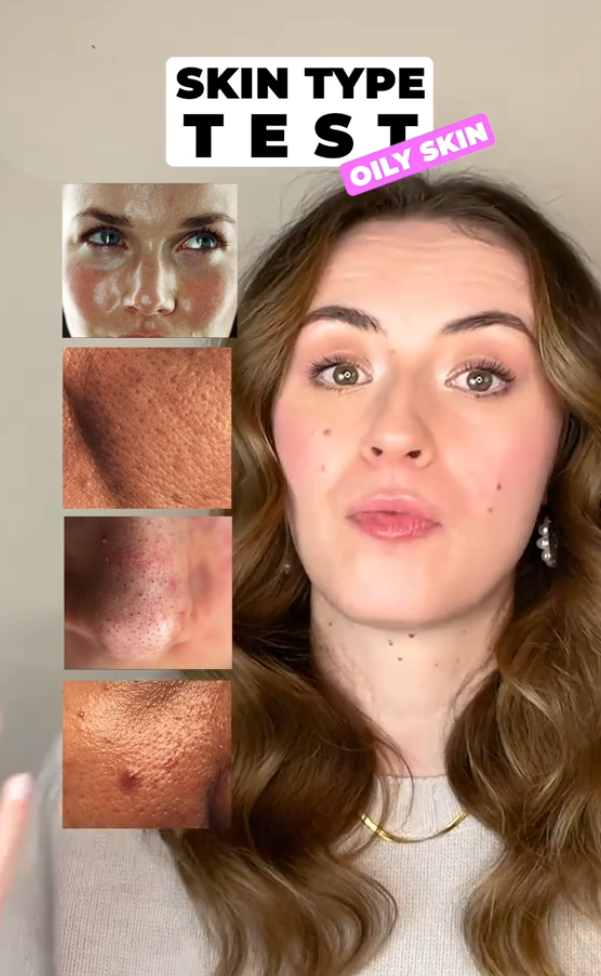Identifying oily skin is key to choosing the right skincare products and routine. Here are some signs and tests to help you determine if you have an oily skin type:
1. **Shiny Appearance**: Your skin tends to look shiny, especially in the T-zone (forehead, nose, and chin).
2. **Large Pores**: You notice that your pores are larger and more visible, particularly around the nose and cheeks.
3. **Frequent Breakouts**: You experience regular breakouts and blackheads due to excess oil production.
4. **Makeup Slippage**: Makeup tends to slide off or become patchy quickly because of the oil on your skin.
5. **Blotting Test**: After cleansing your face, wait for an hour and then press a blotting paper on different areas. If the paper shows significant oil, particularly from the T-zone and other areas, you likely have oily skin.
6. **Thick Texture**: Your skin may feel thick or greasy, even after washing.

When it comes to skincare, knowing your skin type is essential for selecting the right products and achieving your best complexion. Among the different skin types, oily skin is one of the most common. It is characterized by excess oil production, which can lead to a shiny appearance, clogged pores, and potential breakouts. But how do you know if you have oily skin? While some signs are fairly obvious, others may be more subtle. In this article, we’ll explore how to determine if you have oily skin and how to manage it for a healthier, more balanced complexion.

What is Oily Skin?
Oily skin occurs when your sebaceous glands (the glands in your skin responsible for producing oil, or sebum) produce more oil than your skin needs. Sebum is vital for keeping your skin hydrated and protected, but when too much is produced, it can create a greasy or shiny appearance, clog pores, and contribute to acne breakouts. Oily skin can also lead to other conditions like enlarged pores, blackheads, and whiteheads.
However, it’s important to remember that oily skin is not necessarily a bad thing. In fact, some benefits of having oily skin include slower aging and fewer wrinkles since oil helps keep the skin moist and protected from environmental damage. That being said, managing oily skin is essential to maintain its health and appearance.

Signs You Have Oily Skin
There are several telltale signs that suggest you might have oily skin. These signs can appear throughout the day, especially during warmer months or in humid climates. Below are the most common symptoms of oily skin:
1. Shiny or Greasy Appearance
One of the most obvious signs of oily skin is a shiny or greasy appearance, particularly in areas like the forehead, nose, and chin (known as the T-zone). This is due to the excess oil being produced and sitting on the surface of your skin. If you notice a shine, even shortly after washing your face, you likely have oily skin.

2. Frequent Breakouts
Excess oil can clog pores, leading to acne and other skin issues. If you frequently experience pimples, blackheads, or whiteheads, oily skin could be the cause. Breakouts are most common in areas with higher concentrations of sebaceous glands, such as the T-zone, chin, and cheeks.
3. Enlarged Pores
When the sebaceous glands overproduce oil, the pores can become clogged and stretched, leading to enlarged pores. You might notice these larger pores around your nose, forehead, and chin. If you look closely at your skin, you may be able to see the blackheads or oil trapped within these pores.

4. Greasy Feel After Cleansing
If you feel that your skin becomes greasy or slick shortly after washing your face, it’s a sign of excess oil production. In some cases, the skin may feel tight right after cleansing, but this tightness fades quickly, followed by an oily film. This can indicate that your skin is producing more oil to compensate for a perceived loss of moisture.
5. Frequent Need to Blot
If you constantly need to blot your face with a tissue or oil-absorbing sheets throughout the day, it’s a clear indication that you have oily skin. People with oily skin typically need to blot more often because their skin produces excess sebum, which can result in a shiny appearance, especially in the T-zone.
6. Dull Skin in Some Areas
While oily skin can cause shine on the surface, it may also lead to dullness in certain areas. If excess oil clogs pores, it can cause a buildup of dead skin cells, leading to a lackluster complexion. This can be especially noticeable on the cheeks, where the oil buildup may not be as apparent as it is on the forehead or nose.
7. Makeup Doesn’t Stay
Oily skin can make it difficult for makeup to stay in place. If you notice that your foundation or other makeup tends to slide off or wear away quickly, this could be because your skin is producing excess oil that breaks down the makeup throughout the day. This is especially true for liquid foundations and concealers, which tend to separate in oily skin.
How to Confirm If You Have Oily Skin
If you’re not sure whether you have oily skin or not, there are a few simple tests you can try at home to confirm. These tests can help you determine if you’re dealing with oily skin or if other factors, such as dehydration or skin type changes, are causing similar symptoms.
1. The Bare-Faced Test
After washing your face with a gentle cleanser, leave your skin free of any products. Wait for an hour or two and then observe how your skin feels. If it looks shiny, feels greasy, or if you notice the need to blot, your skin is likely oily. On the other hand, if your skin feels tight, dry, or irritated, you may have dry or combination skin.
2. The Tissue Test
This simple test can help determine how much oil your skin is producing. Gently press a clean tissue or blotting paper on different areas of your face, such as your forehead, nose, and chin (T-zone). If the tissue picks up a noticeable amount of oil, your skin is likely oily. If the tissue appears clean, you may have dry or normal skin.
3. Observe Pore Size
Examine your face closely in natural light, paying special attention to the size of your pores. If your pores appear larger or clogged with blackheads, particularly around the T-zone, it’s likely a sign of excess oil production. Healthy skin tends to have smaller pores, while oily skin often has enlarged, clogged pores.
4. The Blotting Sheet Test
Blotting papers are designed to absorb oil from the skin. After a few hours of wear, gently press a blotting sheet on different parts of your face. If the sheet picks up oil from multiple areas, especially the forehead, nose, and chin, it indicates that you have oily skin.
Factors That Contribute to Oily Skin
Oily skin can be influenced by various factors, including genetics, hormones, diet, and environmental conditions. Here are a few key contributors to oily skin:
- Genetics: If your parents have oily skin, it’s likely that you will too. Genetics play a significant role in the size and activity of your sebaceous glands.
- Hormones: Hormonal fluctuations, such as those during puberty, menstruation, pregnancy, or with the use of birth control, can lead to an increase in oil production. Testosterone, in particular, stimulates the sebaceous glands, which can result in oilier skin.
- Diet: A diet high in unhealthy fats, sugars, and dairy products can increase oil production in your skin. On the other hand, a balanced diet rich in antioxidants, vitamins, and omega-3 fatty acids can help support healthy skin.
- Environmental Factors: Hot, humid weather can increase the production of oil, making your skin feel more greasy. Pollution and other environmental toxins can also trigger excess oil production in some people.
- Over-Cleansing or Harsh Products: Using harsh cleansers or exfoliators that strip the skin of its natural oils can backfire, leading to even more oil production. When the skin is stripped of its natural oils, it often compensates by producing more sebum.
How to Manage Oily Skin
Once you’ve determined that you have oily skin, you may wonder how to manage it. Here are a few tips:
- Use a gentle cleanser: Choose a gentle foaming or gel cleanser designed for oily skin. Avoid harsh products that can strip your skin of natural oils, as they can trigger even more oil production.
- Exfoliate regularly: Regular exfoliation helps to remove dead skin cells that can clog pores and cause breakouts. Look for a chemical exfoliant with salicylic acid or glycolic acid.
- Use oil-free or non-comedogenic products: Opt for lightweight, oil-free moisturizers, sunscreens, and makeup that won’t clog your pores.
- Blot during the day: Keep blotting papers or a mattifying powder on hand to help absorb excess oil without disrupting your makeup.
Conclusion
Oily skin is a common skin type that comes with its own set of challenges and advantages. If you notice excess shine, frequent breakouts, or enlarged pores, you may have oily skin. By understanding the signs of oily skin and using the right products and skincare routine, you can maintain a healthy, balanced complexion that feels and looks great. Whether you choose to tackle oily skin with specific treatments or embrace it as part of your natural beauty, knowing your skin type is the first step to healthier, more radiant skin.



